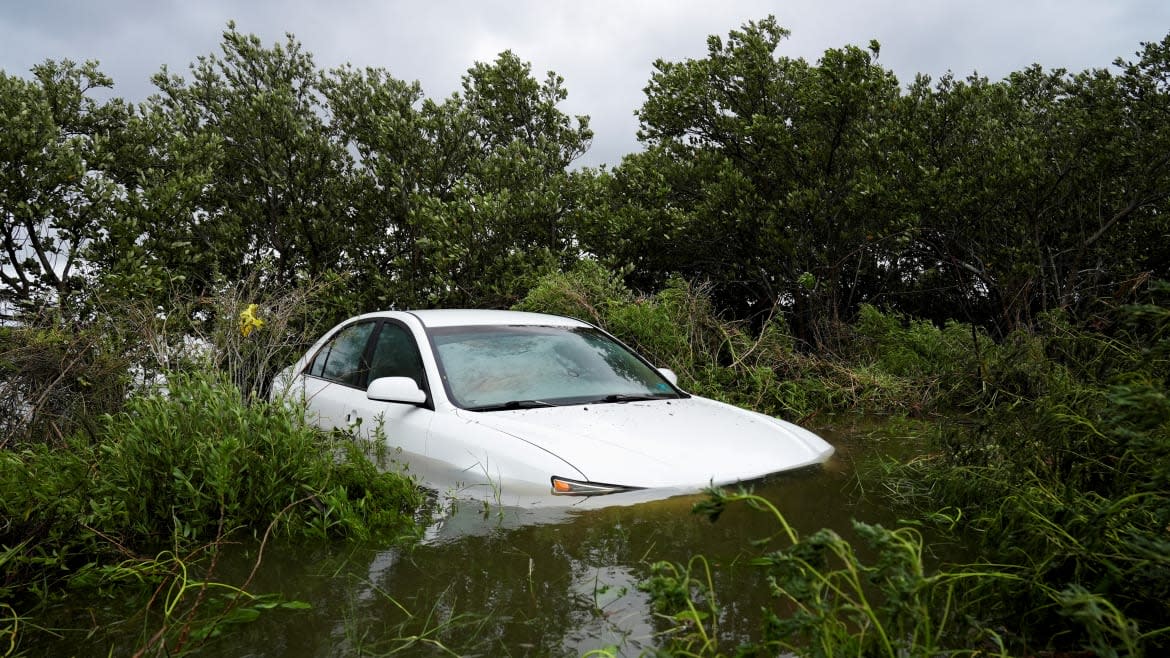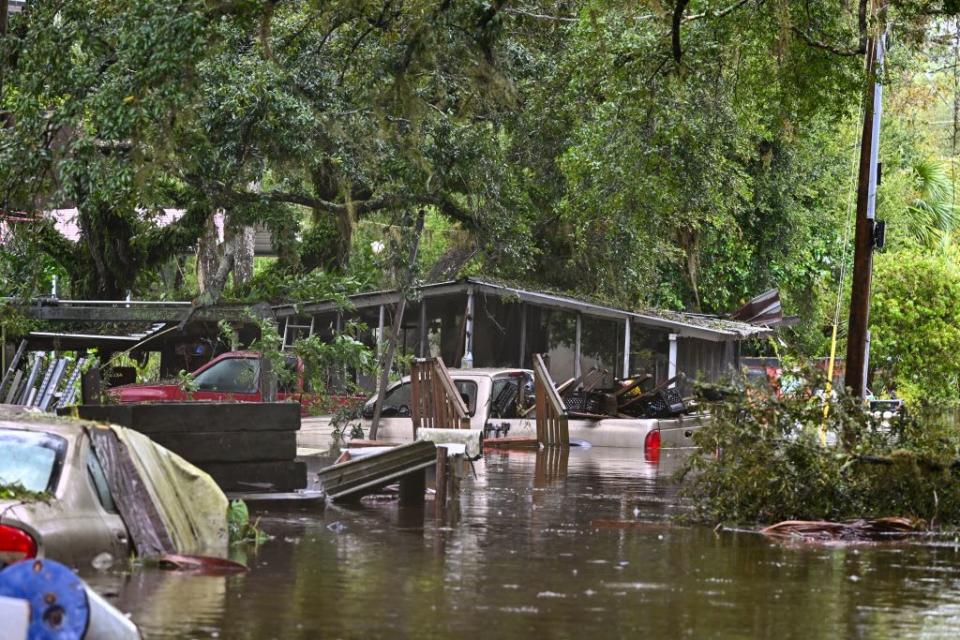Hurricane Idalia Weakens but Still Wreaks Havoc as Tornado Flips Car

Hurricane Idalia was downgraded to a tropical storm Wednesday night, just 10 hours after making landfall on Florida’s Gulf Coast—capping a day of devastation along a series of historic cities in the state’s Big Bend region.
But Idalia’s wrath didn’t stop at the border—nor did it cease once the storm lost its hurricane-strength winds, spawning off tornadoes that continued to damage property and injure people as the storm swept through South Carolina and beyond.
Video taken in Goose Creek, just north of Charleston, shows one such twister gaining enough power to pick up and flip a car, shocking drivers on a local highway. A tornado watch is in effect for much of the state’s coast through 4 a.m. Thursday morning.
NWS Charleston confirmed this car did flip in a weak, brief tornado @Elisa_Raffa reports from the Low Country on @Queen_City_News
(📸: @mom2manygreens / TikTok) #Idalia #Hurricane #flooding #Tornado #goosecreek #SouthCarolina @GooseCreekSC pic.twitter.com/36DAIIK1gi— ALICIA BARNES (@AliciaBarnesTV) August 30, 2023
Authorities in the area cautioned that flooding risks from the torrential downpour would extend into the night, with rivers expected to sustain up to five feet of overflow and storm surges of up to nine feet in the Charlseton Harbor, according to the National Weather Service. As of roughly 8 p.m., the city was experiencing its eighth highest tide on record—with the worst still yet to come.
Idalia first made landfall as an “extremely dangerous” Category 3 hurricane on Wednesday morning with winds near 125 mph and a deadly storm surge that erased miles of southeast Florida’s coastline.
The National Hurricane Center said at 7:45 a.m. ET that the storm had come ashore along the Gulf Coast near Keaton Beach. By 10 a.m., Idalia was downgraded to a Category 1 storm, and by 5 p.m. it no had hurricane-strength winds. Federal forecasters wrote that Idalia still posed a flooding threat to southern Georgia and South Carolina as a massive tropical storm.
A pair of fatal car crashes during the storm killed two men on Wednesday—one in Pasco County, just north of Tampa, and another in Gainesville, home to the University of Florida in north-central Florida. Both men lost control of their vehicles and slammed into trees, according to the Florida Highway Patrol. It’s unclear if the deaths will officially be tied to Idalia, however, as Florida Gov. Ron DeSantis said Wednesday afternoon there were no confirmed fatalities.
Photos and videos of cities directly in Idalia’s path showed mass destruction, with roofs ripped off homes, gas stations and bridges partially toppled, and some downtowns inundated entirely.

A backyard is flooded in Steinhatchee, Florida, by Hurricane Idalia.
More than 363,000 customers were without power in Florida and Georgia as of 9 p.m., according to poweroutage.com. Tampa International Airport, Tallahassee International Airport, and Sarasota Bradenton International Airport were all shuttered ahead of the storm on Tuesday night. Tampa said it reopened its airport for inbound flights at 4 p.m. Wednesday and will reopen entirely on Thursday morning because it suffered “minimal damage.”
In an afternoon update on Wednesday, DeSantis said utility workers were out en masse in rural counties hit hardest, as were search-and-rescue teams. He said the lack of local resources in Florida’s Big Bend region, which has a population of less than 100,000 people, could make recovery take longer than it did after Hurricane Ian hit Southwest Florida last year.
He also issued a stern warning to any would-be thieves taking advantage of the havoc wreaked in the state by Hurricane Idalia: “You loot, we shoot.”
The National Guard said it sent about 5,500 members to Florida to help with rescue and recovery.
President Joe Biden spoke about the storm in a press conference, using it and the recent wildfires in Maui as an example of the world’s growing climate crisis.
“I don’t think anybody can deny the impact of the climate crisis anymore,” Biden said. Idalia was the first major hurricane to strike Florida’s Big Bend region since Hurricane Easy struck nearby as a Category 3 storm in 1950.
Hurricane Idalia caused devastating damage to homes in Florida's Big Bend with maximum sustained winds of 125 mph. pic.twitter.com/IbZiC201WE
— AccuWeather (@accuweather) August 30, 2023
Authorities closed off access to the barrier islands in Manatee and Pinellas counties, home to some of Florida’s most well-known beaches like Clearwater and St. Pete Beach. The storm surge in Cedar Key, a historic “old Florida” city founded in 1842, was as high as at seven feet by Wednesday morning. One local resident described an “apocalyptic scene” from the surge and torrential downpours.
Videos shared on social media appeared to show blackouts and power line flashes in Perry, while extensive flooding has been reported in Tarpon Springs and Steinhatchee.
INCREDIBLE VIDEO | Heartbreaking footage to watch. This is a time-lapse video from Steinhatchee, Florida early Wednesday morning as storm surge from Hurricane Idalia pushed ashore. Surge values could top out over 10 feet in spots around this location. #Idalia #FLwx pic.twitter.com/xyMABT0Ylq
— Zach Covey (@ZachCoveyTV) August 30, 2023
Residents in the Tampa Bay region were warned early Wednesday that even emergency services may not be able to rescue them, with coastal flooding occurring as far as 200 miles south of where Idalia eventually made landfall. “It’s gonna get to a point where we just can not get to you,” Madeira Beach fire chief Clint Belk told CNN.
Police in St. Petersburg also said firefighters had to rescue a person from a flooded mobile home park. Emergency operations were completely suspended in Walkulla County due to the extreme weather. “Emergency personnel and first responders will not be responding to calls for service until the weather improves as the conditions are simply too dangerous,” Wakulla County Sheriff's Office wrote in a Facebook post.
“This thing’s powerful,” DeSantis said Wednesday morning. “If you’re inside, just hunker down until it gets past you. You don’t want to be messing around with these winds. There’s going to be things flying all over the place.”
Get the Daily Beast's biggest scoops and scandals delivered right to your inbox. Sign up now.
Stay informed and gain unlimited access to the Daily Beast's unmatched reporting. Subscribe now.

